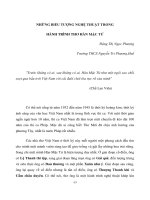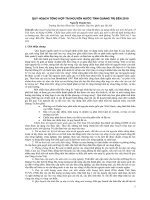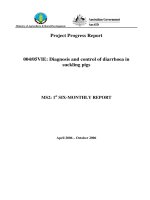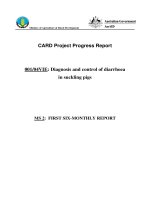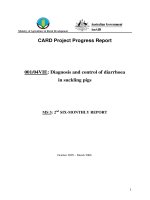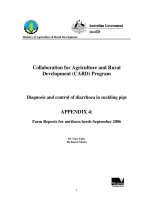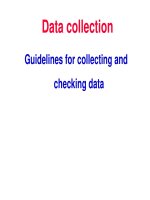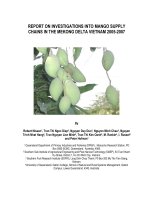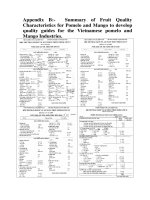Báo cáo nghiên cứu khoa học " RESULTS ON STRENGTHENING DIAGNOSTIC CAPACITY AND CONTROL OF DIARRHOEA IN SUCKLING PIGS " docx
Bạn đang xem bản rút gọn của tài liệu. Xem và tải ngay bản đầy đủ của tài liệu tại đây (426.21 KB, 9 trang )
Collaboration for Agriculture and Rural Development
(CARD)
Program
16
RESULTS
ON STRENGTHENING DIAGNOSTIC CAPACITY AND
CONTROL OF DIARRHOEA IN SUCKLING PIGS
Project title:
Diagnosis and control of diarrhoea in suckling pigs
Project c
ode
:
CARD
001/04VIE
Authors:
Do Ngoc Thuy
1
, Cu Huu Phu
1
, Au Xuan Tuan
1
, Nguyen Xuan Huyen
1
, Truong Van Dung
1
,
Tony Fahy
1
, Steve Driesen
2
, Karen Moore
2
, Aileen Vanderfeen
2
, Darren Trott
3
Collaborating organisations:
1
: National Institute of Veterinary Research
2
: Pig Research Unit,
Vi
ctorian Department of Primary Industry, Melbourne, Australia
;
3
:
The University of Queensland
, Australia
SUMMARY
During the implementation time (2005
-
2007), three objectives of the project, including: 1) Improved
field and laboratory diagnosis of prewean
ing diarrhoea; 2) Production and testing of locally
-
produced E. coli vaccines; 3) Development of a management plan for preweaning diarrhoea using a
continuous improvement (CIP) model had been conducted and completed. Some achievements are: 1)
A diagnostic
procedure of six major causes of
diarrhoea
in suckling pigs has been applied successfully
at Department of Bacteriology, NIVR. 2) A vaccine containing E. coli strains bearing full pathogenic
factors (fimbriae, toxins) has been produced and proven safe and
effective in laboratory and in the
field. 3) An continuous improvement model, focused mainly on management of sows during farrowing
and lactation has been developed and utilized in order to improve pig production and minimize the
losses due to diarrhoea in
suckling period.
1
.
Introduction
Diarrhoea during the suckling period has been
recognised as the principle health problem
affecting both smallholder and commercial pig
production in Vietnam. Previous research (4,
7) has confirmed the presence of a new
fimbrial type in
E. coli
strains causing
colibacillosis in Vietnam that would not be
controlled by existing vaccines. Existing
vaccines are currently imported into Vietnam
at considerable cost. In addition, there are
many other causes of suckling diarrhoe
a, the
significance of which is currently unknown in
Vietnam, which are all affected by husbandry
and management during farrowing and
lactation. Project 001/04VIE (Diagnosis and
control of diarrhoea in suckling pigs) began
with three objectives to solve th
is problem:
1.
Improved field and laboratory diagnosis
of preweaning diarrhoea
2.
Production and testing of locally
-
produced
E. coli
vaccines
3.
Development of a management plan for
preweaning diarrhoea using a continuous
improvement (CIP) model
This pr
oject is designed to improve
productivity of smallholder pig farmers in
Vietnam through improved health
management, particularly of piglets during the
pre
-
weaning period. Through consultation and
dialogue with farmers and field veterinarians,
an appropria
te disease management plan will
be developed. This will concentrate on the
pre
-
weaning period where greatest losses
occur, but will include principles of herd
health management in general. Dissemination
of the plan will be through training
programmes for
field staff and selected
farmers.
CARD
001/04 VIE
–
Control
diarrhoea
in suckling pigs
17
2
.
Project
contents and methods
2
.1
Project
Contents
The project focuses on:
1. Improved laboratory diagnosis of
preweaning diarrhoea
2.
Production and testing of locally
-
produced E. coli vaccines
3.
Development of
a management plan for
preweaning diarrhoea using a
continuous improvement (CIP) model,
training for field veterinarians
2
.2
Method
ology
-
Experimental design based on groups and
compare the significant difference (1 factor,
multiple factors)
-
Isolati
on and identification of bacteria (
E.
coli
,
C. perfringens
) according to SOPs
-
Detection of virus (TGE virus, Rota virus)
by ELISA (commercial kit, Institute
Pourquier)
-
Detection of
Cocci oocysts by standard
faecal flotation
, Cryptosporidium by
modifi
ed Ziehl
-
Neelsen staining of faecal
smears
-
Detection of virulence factors of
E. coli
(fimbriae, toxins) by PCR
-
Production of vaccine according to SOP
3
.
Research results and discussions
3
.1
Development of a procedure for quick
diagnose some of th
e most common
infectious causes of
diarrhoea
in
suckling pigs
A diagnostic procedure of six major causes of
diarrhoea
in suckling pigs, including the
infectious gastroenteritis virus (TGEV), Rota
virus, E. coli, C. perfringens, Coccidiosis and
Cryptospori
dium have been established, in
accordance with the laboratory conditions at
Department of Bacteriology, National Institute
of Veterinary Research. This procedure has
been used for diagnosis of faecal samples
collected from commercial piggeries
(participate
d in the project) and small holder
farmers in the nearby areas. Results are
presented in table 1.
Table 1:
Prevalence of enteric pathogens in pre
-
weaning piglets with diarrhoea
Agent(s) detected
No. of positive samples (%)
Commercial
piggeries (n=117)
Small holder
farmers (n=45)
Cocci
2 (1.7)
Crypto
3 (2.5)
RV
3 (2.5)
TGEV
11 (9.3)
ETEC
4 (3.4)
C. per
2 (1.7)
Total single infection
25 (21.2)
RV
ETEC
6 (5.1)
RV
TGEV
17 (14.4)
3 (6.7)
Cocci
RV
1 (0.8)
2 (4.4)
Cocci
Crypto
1 (0.8)
2 (4.4)
Crypto
ETEC
3 (2.5)
1 (2.2)
Crypto
C. per
1 (0.8)
1 (2.2)
Crypto
TGEV
6 (5.1)
2 (4.4)
TGEV
C. per
1 (0.8)
D.
N Th
u
y, C
.
H Phú,
A
X. Tu
a
n, N. X.Huy
e
n, T.V. Dung, T. Fahy, S.Driesen, K. Moor
e, A. Vanderfeen
&
D. Trott
18
Agent(s) detected
No. of positive samples (%)
Commercial
piggeries (n=117)
Small holder
farmers (n=45)
TGE
V
ETEC
7 (5.9)
Cocci
RV
ETEC
2 (1.7)
3 (6.7)
Cocci
RV
TGEV
4 (3.4)
3 (6.7)
Cocci
TGEV
ETEC
2 (1.7)
2 (4.4)
Cocci
Crypto
RV
1 (0.8)
1 (2.2)
Crypto
TGEV
ETEC
5 (4.2)
4 (4.4)
Crypto
RV
ETEC
1 (0.8)
3 (6.7)
Cryp
to
TGEV
C. per
1 (0.8)
1 (2.2)
Crypto
RV
TGEV
3 (2.5)
RV
TGEV
ETEC
14 (11.9)
7 (15.6)
RV
TGEV
C. per
1 (0.8)
1 (2.2)
RV
ETEC
C. per
2 (1.7)
3 (6.7)
TGEV
ETEC
C. per
2 (1.7)
Crypto
RV
TGEV
ETEC
2 (1.7)
1 (2.2)
Crypto
RV
ETEC
C. per
1 (0.8)
2 (4.4)
Cocci
Crypto
RV
TGEV
1 (0.8)
1 (2.2)
Cocci
Crypto
TGEV
C. per
1 (0.8)
Cocci
RV
TGEV
ETEC
4 (3.4)
1 (2.2)
Cocci
Crypto
RV
TGEV
C. per
1 (0.8)
1 (2.2)
Crypto
RV
TGEV
ETEC
C. per
1 (0.8)
(3
6)
(50)
(97)
(111)
(76)
(23)
Total multiple infections
92 (78.8)
45 (100.0)
3.2
Production and testing of local
produced E. coli vaccine
A vaccine containing
E. coli
strains bearing
full pathogenic factors (fimbriae, toxins) has
been pro
duced according to SOP. Specialised
culture media were prepared in order to
provide favourable growth conditions for the
production of fimbriae. Each dose of vaccine
(2 ml) contains of ~ 1.5 x 10
9
bacteria. Vaccine
has been tested on sterility, safety and
efficacy
in laboratory and in the field (for small scale
trial).
CARD
001/04 VIE
–
Control
diarrhoea
in suckling pigs
19
Results of ELISA for efficacy testing of
vaccine show that there was a significant
difference between the OD levels for the
treatment groups (p<0.003). There was no
significant difference
between the antibody
response elicited (as demonstrated by OD
values) by Litterguard, EcoVac or NIVR
vaccines (p>0.1). All three vaccines were
significantly different from the control group
(p< 0.005) (Table 2)
Table 2
:
Mean OD values of sera between
tre
atment and control group
Treatment group
Mean
Control
0.2260
a
Litterguard
0.8129
b
EcoVac
0.9406
b
NIVR
0.8695
b
* Means with different subscripts differ
significantly p<0.005
Vaccine was tested in some piggeries in the
North. Pregnant sows twice at
9 and 12 weeks
of gestation each received 2 ml of vaccine
(approximately 1.5 x 109 bacteria). Results
show that under experimental conditions, the
vaccine is both safe (100%) and efficacious
(>85%). No local or systemic reaction to the
vaccine was observed
and all sows gave birth
at the correct stage of gestation to an average
of 9.3 healthy piglets per sow. The prevalence
of pre
-
weaning diarrhoea in piglets born from
vaccinated sows at 1, 2 or 3 weeks of age
were: 16.1; 22.7 and 26.5%, compared with
those
of 48.1; 33.8 and 37.5%, respectively
from control group (P<0.005).
3.
3
Recommendations
on herd health
monitoring
II.3.1. Sow management
o
Pigs must have access to feed at least
daily and the diet must be nutritionally
adequate to maintain health and meet
the
requirements for maintenance, growth,
pregnancy and lactation.
o
When the body condition score of a pig
falls below 2.5 (on the scale of 1
-
5,
appendix 1), remedial action must be
taken.
o
All pigs (excluding piglets) must be
maintained at a body condition
score of 2
or more.
o
Feed must be provided in such a way as to
prevent undue competition or injury.
o
Pregnant sows should be given enough
bulky or high fibre feed to satisfy hunger.
The feed intake for dry sows needs to be
nutritionally balanced, appropriat
e to the
sow’s physiological needs (which vary
during pregnancy) and to provide satiety
without the sow becoming overweight.
o
Body score of breeding sows at farrowing
should be 3.5
–
4.
o
Body score of breeding sows at weaning
should be 3 or above.
o
Condition
scoring is recommended as a
way of assessing the adequacy of
nutrition, along with monitoring of health
and
productivity. A guide to condition
scoring of pigs is given in the next part.
o
Drinkable water and/or other wholesome
liquid must be easily availabl
e to pigs in
sufficient quantities to meet the
physiological needs of the pigs at all times
o
Water provided should be fresh, palatable,
and at a temperature that does not inhibit
drinking.
o
Drinker allocation per pen group and
drinker design and flow rates s
hould be
such that water requirements of different
classes of pig are easily met.
o
Pigs should have constant access to water
or other suitable wholesome liquid. The
daily consumption of
water (or
other
wholesome liquid)
by a pig will vary
according to envir
onmental temperature
,
diet ingredients
and live
-
weight.
* Feed requirements for lactating sows
The minimum feed recommended intakes for
lactating sows as follows:
D.
N Th
u
y, C
.
H Phú,
A
X. Tu
a
n, N. X.Huy
e
n, T.V. Dung, T. Fahy, S.Driesen, K. Moor
e, A. Vanderfeen
&
D. Trott
20
Table 3:
Feed requirements for lactating sows
Day of lactation
Daily feed
requirement (
kg)
1
2.5
2
3
3
3.5
4
4
5
4.5
6
5
7
5.5
8
6
9
7
10
8
11
-
15
9
16
-
20
10
21
-
28
10.5
* WATER REQUIREMENTS
For planning purposes the following
consumption estimates are provided for normal
ambient temperatures:
Table 4
:
Average water consumption
(litres
per day)*
Boar or dry sow
12
–
15
Sow and litter
25
–
45
Grower pig:
25 kg
45 kg
65 kg
3
–
5
5
–
7
7
–
9
90 kg
9
–
12
Flow rates will vary depending on the number
of drinking points and care should be taken to
ensure adequate pump capacity and
supply to
maintain flow.
Recommended water flow rates and maximum water pressures
Class
Flow Rate
(litres/minute)
Maximum pressure
(kPa)
Weaners
0.5
85
-
105
Growers/Finishers
1.0
140
-
175
Dry sow
1.0
No limit*
Lactating
2.0
No limit*
* Care shou
ld be made not to have excessive pressure as water wastage can occur.
* TEMPERATURE REQUIR
EMENTS
Pigs, except the very young, are able to
tolerate a wide range of temperatures without
detriment to their well being, provided
temperature changes do not o
ccur abruptly.
During very hot weather (35°C or more) adult
pigs are very susceptible to heat stress, and
steps should be taken to alleviate distress and
avoid deaths. Pigs may die if transported in
very hot weather. The heat index in most sheds
we visite
d was 37
-
38°C.
CARD
001/04 VIE
–
Control
diarrhoea
in suckling pigs
21
The ranges of temperature that afford optimum comfort for different classes of pigs are:
Piglets
—
newborn
30
–
35°C
Piglets
—
3 weeks of age
24
–
30°C (reducing to 26°C at 5 weeks of age)
Farrowing house
16
-
22°C
Weaners
28
–
30°C first
week (start at 30C, reduce by 2
°
C per week to
22
°
C)
Growers
Aim for 20
-
24°C, aim to keep daily fluctuations below 6
°C
Finishers
Aim for 20
-
24°C, aim to keep daily fluctuations below 6
°C
Sows and boars
18
–
24°C, aim to keep daily fluctuations below 6
°C
Table 5:
Thermal comfort zone (assuming concrete floors, no drafts and 15% skin wetness)
Stock
Weight (kg)
Lower critical temp
Evaporative critical temp
Weaners
5
27
30
6
25
29
7
22
28
8
21
26
9
20
25
Growers
20
16
30
50
12
28
90
9
27
Dry
sows & boars
150
15
27
Lactating sows
150
10
23
At the lower critical temperature pigs
will feel cold, huddle and change
position to conserve heat. They will
also need more feed to generate heat.
At the upper limit (evaporative critical
temperature) t
he pigs will begin to
pant in an effort to cool down.
3
.3.1. Condition scoring of sows
The following
criteria can be used as reference for
scoring sows:
D.
N Th
u
y, C
.
H Phú,
A
X. Tu
a
n, N. X.Huy
e
n, T.V. Dung, T. Fahy, S.Driesen, K. Moor
e, A. Vanderfeen
&
D. Trott
22
Condition scoring of sows
Numerical
Score
Pelvic Bones,
Tail Head
Loin
Vertebrae
Ribs
1
Pelvic bones
very prominent.
Deep cavity
around the tail
head.
Loin very
narrow. Sharp
edges on
transverse spinal
process. Flank
very hollow.
Prominent and
sharp
throughout the
length of the
backbone
Individual ribs
very
prominent
2
Pelvic bones
obvio
us but
some slight
cover. Cavity
around tail head.
Loin narrow.
Only very slight
cover to edge of
transverse spinal
process. Flank
rather hollow.
Prominent
Rib cage less
apparent.
Difficult to see
individual ribs
3
Pelvic bones
covered.
Edge of
transve
rse spinal
processes
covered and
rounded.
Visible over the
shoulder. Some
cover further
back.
Covered but
can be felt.
4
Pelvic bones
only felt with
firm pressure.
No cavity
around tail.
Edge of
transverse spinal
processes felt
only with firm
pressure
.
Felt only with
firm pressure
Rib cage not
visible. Very
difficult to feel
any ribs.
5
Pelvic bones
impossible to
feel. Root of tail
set deep in
surrounding fat.
Impossible to
feel bones.
Flank full and
rounded.
Impossible to
feel vertebrae.
Not po
ssible to
feel ribs.
4
.
Conclusions and recommendation
s
4.1
Conclusions
A diagnostic procedure of six major
causes of diarrhea in suckling pigs,
including the infectious gastroenteritis
virus (TGEV), Rota virus,
E. coli
,
C.
perfringens
, Coccidiosis
and
Cryptosporidium have been
established. This procedue can be
easily applied for diagnosis in
laboratory conditions in Vietnam.
A vaccine containing
E. coli
strains
bearing full pathogenic factors
(fimbriae, toxins) has been produced
and proven safe and
effective
in
CARD
001/04 VIE
–
Control
diarrhoea
in suckling pigs
23
laboratory and in the field.
Vaccine
can be used to vaccinate pregnant sows
twice at 9 and 12 weeks of gestation,
each received 2 ml of vaccine to
control diarrhoea in suckling pigs.
An
continuous improvement model,
focused mainly on managemen
t of
sows during farrowing and lactation
has been developed and utilized in
order to improve pig production and
minimize the losses due to diarrhoea in
suckling period.
4.2
Recommendations
The
E. coli
vaccine should be commercialised
as soon as possibl
e so that it can be used for
control of diarrhoea in suckling pigs in
Vietnam
References
1.
Cu Huu Phu, Nguyen Ngoc Nhien, Do
Ngoc Thuy, Au Xuan Tuan, Nguyen Xuan
Huyen, Van Thi Huong, Vu Ngoc Quy.
Results on investigation of diarrhoea in
suckling pigs i
n North Vietnam,
prevalence of antimicrobial resistance and
virulence factors of obtained E. coli
isolates. Proceedings of NIVR
–
35 years
of establishment and development, 1969
-
2004. Agriculture Publishing House.
2004. Pp 126
-
136.
2.
Do Ngoc Thuy,
Darre
n Trot, Cu Huu Phu,
Nguyen Xuan Huyen, Au Xuan Tuan, Van
Thi Huong, Vu Ngoc Quy.
Application of
PCR on examination of virulence factors
of
E. coli
strains obtained from piglets
with diarrhoea in North Viet Nam.
Veterinary Sciences and Techniques. Vol.
XII,
No5. 2005.P 13
-
17.
3.
T
-
N Do, KM Townsend, AJ Frost and DJ.
Trott. 2003.
Pathogenicity of Vietnamese
ETEC in day
-
old piglets.
Proceedings of a
combined annual scientific meeting and
exhibition of the Australian and New
Zealand societies for Microbiology.
Auckland, New Zealand, 28 September
-
2
October, 2003.
p. 82.
4.
Ngoc Thuy Do. 2004.
The significance of
enterotoxigenic
E. coli
as a cause of pre
-
weaning diarrhoea piglet in North Vietnam.
Ph.D Thesis. The University of Queensland.
Brisbane, Queensland, A
ustralia.
5.
Do TN, Wilkie, I, Frost AJ and DJ Trott.
2004.
Pathogenicity of Vietnamese ETEC
strains in colostrum deprived, day
-
old
piglets
Proceedings of the 18
th
IPVS
Congress, Hamburg, Germany,
June 28 to
July 1, 2004. International Pig Veterinary
Soc
iety 2004.
p. 285.
6. TN Do, HP Cu, XH Nguyen, XT Au, NQ
Vu, KM Townsend, B McCormick, AJ
Frost and DJ Trott. 2004.
Pathotypes and
serotypes of ETEC isolates obtained from
piglets with diarrhoea in North Vietnam.
Proceedings of the 18
th
IPVS Congress,
Hamb
urg, Germany,
June 28 to July 1,
2004. International Pig Veterinary Society
2004.
p. 318.
7. N.T. Do, I. Wilkie, S. J. Driesen, V. A.
Fahy, and D. J. Trott. 2006.
Pathogenicity
of Vietnamese Enterotoxigenic
Escherichia
coli
strains in colostrum
-
deprived on
e
-
day
-
old piglets.
Veterinary Pathology
43
, 150
-
160.
8. Thuy, N. Do, Phu H. Cu, Huyen X. Nguyen,
Tuan X. Au, Quy N. Vu, Steve J. Driesen,
Kirsty M. Townsend, James J
-
C. Chin and
Darren J. Trott. 2006.
Pathotypes
and
serogroups of enterotoxigenic
Escherich
ia
coli
isolated from pre
-
weaning pigs in
North Vietnam.
Journal of Medical
Microbiology
55
, 93
-
99.
9. Do NT, Cu HP, Van TH, Nguyen XH, Au
XT, Vu NQ, Fahy VA, Driesen SJ, Moore
K, Vanderfeen A, and Trott DJ. 2006.
Prevalence of the six most common
infectio
us causes of pre
-
weaning diarrhoea
in piglets in Vietnam.
Proceedings of the
19
th
IPVS Congress, Copenhagen,
Denmark
,
July 16
-
19, 2006. International
Pig Veterinary Society 2006.
p. 318.
10. N. T. Do, H. P. Cu, N. N. Nguyen, X. H.
Nguyen, X. T. Au, T. H. V
an, N. Q. Vu and
D. J. Trott.
2006.
Antimicrobial resistance
phenotypes of ETEC isolates from piglets
with diarrhoea in North Vietnam.
Annals of
D.
N Th
u
y, C
.
H Phú,
A
X. Tu
a
n, N. X.Huy
e
n, T.V. Dung, T. Fahy, S.Driesen, K. Moor
e, A. Vanderfeen
&
D. Trott
24
the New York Academy of Sciences
.
1081
:
543
-
545.
11. Trott DJ, Smith M, Do NT. 2006.
Comparative resistance pr
ofiles of
Enterotoxigenic
Escherichia coli
isolated
from Australia and Vietnam.
Proceedings
of the 19
th
IPVS Congress, Copenhagen,
Denmark
,
July 16
-
19, 2006. International
Pig Veterinary Society 2006.
p. 462
12. Do Ngoc Thuy. 2008. Virulence
characterizati
on of Vietnamese strains of
E.
coli
causing diarrhoea in pigs.
Proceedings
of the
1
3
th
Animal science congress of the
Asian
–
Australasian association of animal
production societies. September 22
-
26,
2008. Hanoi, Vietnam.
p. 479.
13. D. N. Thuy, A. X. Tua
n
, T. V. D. Kien
, L.
T. M. Hang, H. N. Duyet, N. V. Chao, C.
H. Phu, T. T. B. Duyen, N. Q. Linh, C.R.
Parke, D. J. Trott. Field Efficacy
of a
locally produced vaccine for the control of
pre
-
weaning Colibacillosis in Vietnam.
Proceedings of the 14th Anima
l Science
Congress of the Asian
–
Australasian
association of animal production societies.
August 23
-
27, 2010. Pingtung, Taiwan,
ROC. p. 459.
14. M. G. Smith, d. Jordan, t. A. Chapman, j.
J
-
c chin, m. D. Barton, t. N. Do, v.a. fahy,
j.
M. Fairbrother, d
.
J.
Trott.
2010
.
Antimicrobial resistance and virulence gene
profiles in multi
-
drug resistant
enterotoxigenic
escherichia coli
isolated
from pigs with post
-
weaning diarrhoea.
Veterinary microbiology
.
[epub ahead of
].
15. Xi
-
Yang Wu, Toni Chapman, Darr
en J.
Trott, karl Bettelheim, Thuy N. Do, Steve
Driesen, Mark J. Walker, and James Chin.
2007.
Comparative analysis of virulence
genes, genetic
diversity
, and phylogeny of
commensal and Enterotoxigenic
Escherichia coli
isolates from weaned pigs.
Applied an
d Environmental Microbiology
73
, 83
-
91.
